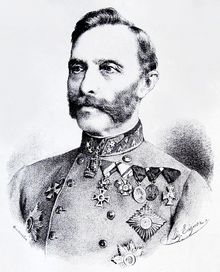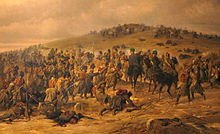Vincenz from Abele
Baron Vincenz von Abele (born April 10, 1813 in Baden near Vienna , † February 19, 1889 in Graz ) was an Austrian Imperial and Royal Privy Councilor , Feldzeugmeister and owner of Infantry Regiment No. 8.
biography
Years of development
Abele joined Infantry Regiment No. 17 in 1831, served in the same as ensign, lieutenant and first lieutenant and participated in all events in Romagna from 1831 to 1835 in this regiment .
Translated from 1847 as captain to infantry regiment No. 15, fought off Vienna in 1848, where, among other things, he safely accompanied the highest court camp to Hadersdorf and in 1849 during the Hungarian uprising . Here he stood out as commander of Landwehr Battalion No. 15 through the resolute defense of Nagy-Sarló on April 19, 1849, where he was seriously wounded, captured and freed by a Russian patrol unit. For his brave behavior Abele received the Military Merit Cross with (subsequently) the War Decoration (KD.) And was immediately promoted to major .
Transferred to the adjutant corps in 1856, the officer advanced to lieutenant colonel . He took part in the campaign of 1859 in Italy as adjutant of the 2nd Army Corps. In the battle of Magenta he - according to the corps commander's relationship - had a very beneficial effect on the course of the battle through his resolute behavior, brought thrown detachments to be razed and re-proceeded, gathered people and artillery in front of Corbetta , especially when retreating, and put them in order to Cisliano . For these particularly praised brave achievements he was awarded the Order of the Iron Crown 3rd Class with War Decoration (KD.) (July 3, 1859), then in December 1859 appointed Colonel and Commander of Infantry Regiment No. 72. On March 12, 1860, he was raised to the hereditary-Austrian knighthood because of his "achievements in the field".
The commander of the Freiherr von Ramming 72 infantry regiment participated in the 1864 German-Danish War campaign . After the final defeat of the Danish King Christian IX. On July 14th, the colonel was given the honor of planting the Austrian banner next to the Prussian banner at the northernmost point of Jutland , Cape Skagen , after which the possession of Jutland was solemnly announced to the sound of the two national anthems and the thunder of the guns. He was later assigned to the military government for Jutland and awarded the Royal Prussian Order of the Crown, 2nd class, with star and swords. After Major General Ritter von Kalik fell ill , Abele took command of his brigade stationed in Holstein as Colonel Brigadier. At the beginning of the hostilities with Prussia in 1866 he vacated the country and joined the Northern Army in Bohemia .
As a general
The baron became major general on July 1, 1866 . There he was assigned to the 1st Corps, already intervened in the war near Podol and particularly distinguished himself in the battle of Gitschin , where he succeeded in repelling Tümping's flank attack and then forcing his brigade to retreat. He also fought brilliantly in the Battle of Königgrätz . The Corps-Command-Relation says about this: “Major-General Abele has distinguished himself very carefully by carefully leading his brigade near Jičín , but especially in the battle of Königgrätz, where this capable general managed to keep his brigade in order in the most violent fire when the loosening of the tactical association was already general. This general knew how to influence his troops in the best possible way, and the exemplary attitude of the brigade during the entire campaign proved this. ”He was also decorated for his brave and excellent achievements with the Knight's Cross of the Order of Leopold.
In 1870 he became the commander of the 2nd division. His appointment as field marshal lieutenant took place on April 26, 1871 and in 1873 he was assigned to the general command in Vienna. On the occasion of his fiftieth anniversary of service, Emperor Franz Joseph I awarded him the Order of the Iron Crown, 2nd class, with a very high handwriting of April 25, 1875, in recognition of his dutiful and excellent services, and he was subsequently awarded the diploma of August 2, 1876 in the Austrian baron was raised.
By the very highest resolution of Emperor Franz Joseph I on December 16, 1877, the baron became the owner of Infantry Regiment No. 8, on April 4, 1879 with the dignity of a Privy Council and on October 20, 1881 with the Order of the Iron Crown 1 .Class excellent.
The general, who also owned the Imperial Russian Order of St. Anne 1st Class, the Grand Cross of the Royal Italian Order of the Crown and the Persian Order of the Sun and Lions, retired on September 1, 1882 at his request, using the expression of The highest satisfaction was expressed and the Feldzeugmeister character was given ad honores.
Awards
The Feldzeugmeister was decorated many times, including:
- Military Merit Cross with War Decoration, 1849
- Prussian Order of the Crown, 2nd class, with star and swords, 1864
- Knight's Cross of the Leopold Order , 1866
- Order of the Iron Crown 2nd class, 1881
- Russian Order of Saint Anne I. Class
- Grand Cross of the Order of the Crown of Italy
- Grand Cross of the Persian Order of the Sun and Lions with Star
family
Abele married Julie Dorothea Dittl in Vienna on December 1, 1849 (* January 21, 1822 in Laibach ; † May 15, 1913 in Graz). The couple had two children, their son Vinzenz (born November 19, 1854 in Lemberg ; † April 14, 1917 in Vienna), later an Austro-Hungarian Lieutenant Field Marshal (rank of November 6, 1912) and daughter Julie. The son from her marriage to Theodor Stimpfl, († December 27, 1911 in Freudenthal ), Theodor Freiherr von Stimpfl-Abele (born May 4, 1880 in Salzburg ), kuk Rittmeister on May 2, 1918 , continued the family. Since his uncle had remained single, he was the last of the sex to have the right to combine his mother's title of baron with his father's real name.
Regarding the elevation to the nobility in this regard: The emperor has given the kuk Feldmarschalleutnant Vinzenz Freiherr von Abele the tax-free transfer of his name, baron class and coat of arms to his nephew, the kuk Oberleutnant d. R., Theodor Stimpfl factory and estate owner in Freudenthal near Frankenmarkt , approved on October 26, 1914.
coat of arms
1876: Shield split, right in black a crowned golden eagle at the crack, left split, above in gold over natural river a burning wooden bridge with three pillars in the middle, below in blue a green mountain. - Two helmets, on the right one with black and gold covers a closed flight, gold in front, black behind, on the left with blue and gold covers a curved, splinted sword arm. Shield holders are two golden lions.
The family of field marshal lieutenant Albert Abele von und zu Lilienberg is not related to this, nor is any other Abele family who received the Württemberg nobility in 1819. This can already be verified by the different coats of arms.
Web link
Individual evidence
- ^ Andreas Graf Thürheim: "Memorial sheets from the war history of the Austro-Hungarian Army", Volume 1, Verlag der Buchhandlung für Militär-Literatur K. Prochaska, Vienna and Teschen 1880, p. 35
- ↑ a b Die Vedette No. 16, from Sunday, February 24, 1889, p. 130
- ↑ K. k. Army Ordinance Gazette, No. 43 of July 3, 1859, KK Hof- und Staatsdruckerei, Vienna 1859, p. 190
- ↑ a b c Franz Pollak: “History of K. u. K. Infantry Regiment Archduke Carl Stephan “, Volume 3, printed by Rudolf M. Rohrer, Brünn 1892, p. 399 ff.
- ↑ a b c Oscar Goeschen and AM Hildebrandt: "Kärntner Adel", in Siebmacher's large Wappenbuch, vol. 4, Bauer & Raspe, Nuremberg 1879, p. 67
- ↑ Die Vedette No. 1656, from Saturday, July 18, 1914, p. 5
- ^ V. Streffleur (Ed.): "Österreichischemilische Zeitschrift", vol. Vol. 3, Druck- und Kommissionsverlag Carl Gerold's Sohn, Vienna 1864, Personalnachrichten p. 155
- ↑ a b c d Antonio Schmidt-Brentano: The kk or kuk Generalität 1816–1918, Austrian State Archives, Vienna 2007, p. 3
- ↑ Geoffrey Wawro: "The Austro-Prussian War: Austria's War with Prussia and Italy in 1866", Cambridge University Press, Cambridge 1997, pp. 186 f., ISBN 978-0-521-62951-5
- ↑ Military newspaper No. 15, of Friday, February 22, 1889, p. 118
- ^ History of the KuK Infantry Regiment: Archduke Carl Stephan, Volume 3, p. 399 ff.
- ↑ Gothaisches genealogical pocket book of the baronial houses for the year 1931, Verlag Justus Perthes, Gotha 1931, p. 511
- ↑ Linzer Volksblatt No. 244, from Tuesday, October 26, 1914, p. 4
- ↑ Peter Frank-Döfering: “Adelslexikon des Österreichischen Kaisertums 1804-1918”, Volume 2 (1823-1918), Verlag Herden, Vienna 1989, p. 220
| personal data | |
|---|---|
| SURNAME | Abele, Vincenz of |
| BRIEF DESCRIPTION | Austrian kuk Feldzeugmeister |
| DATE OF BIRTH | April 10, 1813 |
| PLACE OF BIRTH | Baden near Vienna |
| DATE OF DEATH | February 19, 1889 |
| Place of death | Graz |




